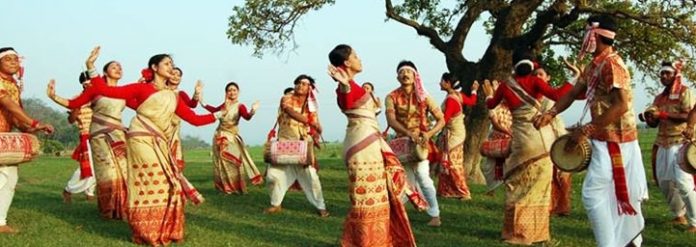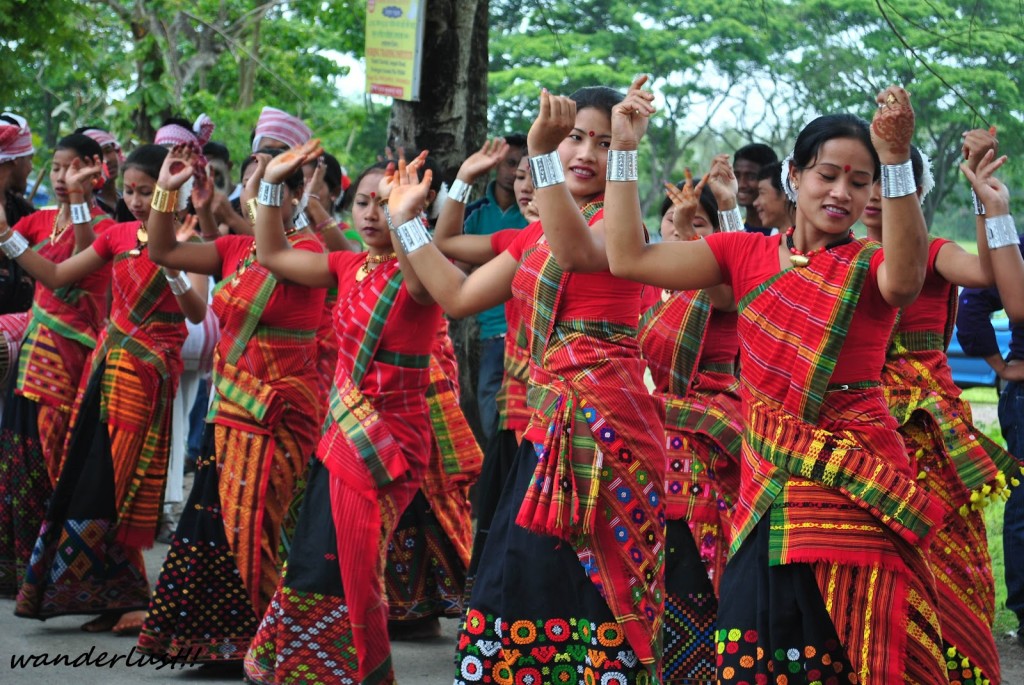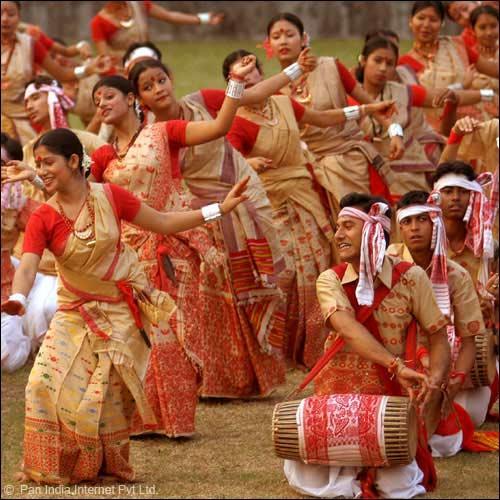In 2019, Bohag Bihu commences on April 15 and ends on April 21.
Seven-day celebration (7 pinnacle phases) of Bohag Bihu
The seven-day festival is also called as ‘Xaat Bihu’ and the days are known as Raati Bihu, Chot Bihu, Goru Bihu, Manuh Bihu, Kutum Bihu, Mela Bihu, and Chera Bihu.
Bihu in Assam is celebrated thrice throughout the year, although the New Year Bihu is specifically called the Rongali Bihu or the Bohaag Bihu. Bohaag Bihu is celebrated on the first day of the first month of the solar calendar known as Bohaag, which coincides with mid-April as per the Gregorian calendar. Bohaag Bihu is celebrated by the entire state as this is a cultural celebration and alludes to the harvest season.
Background
Bihu is derived from the Sanskrit word ‘Vishu’. It not only marks the beginning of the New Year but also signifies the beginning of the harvest season in Assam. The festivities of Bihu are spread over a period of seven days and each day is devoted to a special custom. Largely, the festival revolves around the preparation of special food items and celebrations that include the famous Bihu dance, which is a local form of dance.
Sources of Inspiration
Known as Rongaali Bihu as well, the word Rongaali is derived from the Assamese word for joy i.e. Rong.
Celebrations
The first of the seven days of Rongaali Bihu is known as the Goru Bihu and involves giving the cattle a bath while using soaps and herbs that are considered auspicious. The ritual is accompanied by a folk song.
The following day is considered the most important day of Bohaag Bihu and commences the New Year. Special respect is paid to the elders of the family by giving them a towel called the Gamosa. This is one of the most important rituals and the towel is worn on the head and body. The Gamosa is a symbol of the highest respect in the Assamese community.
The rest of the days of Bihu are known as Manuh Bihu, Kutum Bihu, Senehi Bihu, Mela Bihu and Chera Bihu.
Another highlight of this festival is a bamboo hat known as the Japi. This hat is important as it symbolizes the importance of agriculture in Assam. Farmers wear a simpler form of the Japi while working in the fields.
During the seven-day celebrations, Bihugeet or songs about the festival are sung, especially in rural areas. Many of these songs communicate feelings of attraction, love and romance among the younger members of the community. These folk songs are accompanied by traditional instruments like the Dhol, Pepa, Toka , Gagana and more. Bihu dance performances are also very common during these seven days. This was earlier a door-to-door performance, although community performances are more popular now.
Bohag Bihu also called as Rongali Bihu, is the most celebrated Bihu among the three, as it celebrates Assamese New Year and the beginning of the agricultural season. Bihu refers to a set of three different festivals namely Rongali or Bohag Bihu (celebrated in April), Kongali or Kati Bihu (celebrated in October) and Bhogali or Magh Bihu (celebrated in January). Bohag Bihu is celebrated by gorging on traditional Assamese food and preparing the fields for cultivation of paddy. It is also a fertility festival, where people, especially women, dance with their signature steps using hips and arms. The songs associated with the festival are called Bihu geets or Bihu songs. To celebrate the festival of harvest and the abundance of crops, Bohag Bihu is celebrated by cooking green leafy vegetables. Other food items that hold significance during the festival are rice, sesame, milk, jaggery, and milk products.
In 2019, Bohag Bihu commences on April 15 and ends on April 21.
Seven-day celebration (7 pinnacle phases) of Bohag Bihu
The seven-day festival is also called as ‘Xaat Bihu’ and the days are known as Raati Bihu, Chot Bihu, Goru Bihu, Manuh Bihu, Kutum Bihu, Mela Bihu, and Chera Bihu.
Raati Bihu
This phase commences on the first night of Chaitra and lasts till Uruku. Celebrations involve the gathering of local women of the local women in an open field illuminated by lighting up the torches. Men folks participate to play ‘pepa‘, an instrument made from buffalo hornpipe, and ‘bholuka baahor toka‘, a musical instrument made of split bamboo.
Chot Bihu
Also known as Bali Husori, the phase begins on the second day of Chaitra and is celebrated by organising dance and song events by the young at a field or a community prayer hall.
Goru Bihu
It is the last day of Chaitra month. On this day, cattle are brought to a water source and are washed and cleaned using turmeric and gram paste. The cattle are thanked for giving good harvest and are offered vegetables and ‘Bor Pitha’ – a delicacy made from rice and jaggery. The day ends by burning rice bran.
Manuh Bihu
Manuh Bihu falls on the first day of the Vaisakh month and is celebrated by having a special bath, seeking blessings from elders and wearing new clothes. The elders in the family are gifted the Gamusa cloth or Bihuwan as a symbol of cultural pride and respect.
Kutum Bihu
On this day, people visit the houses of their relatives and friends to greet and bond over a meal. ‘Kutum’ symbolizes family.
Mela Bihu
The day is marked by cultural events, fairs, and competitions. These fairs and events are attended by people from all over Assam.
Chera Bihu
Also called as Bohagi Bidai, it the last day if Rangali Bihu and is celebrated differently in different regions. The common theme is to wrap the festival with future resolutions. On this day people exchange ‘pithas‘ among their family and friends.























































